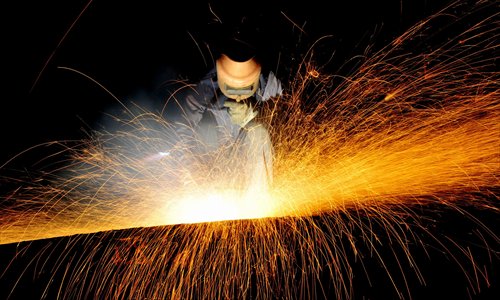SOURCE / INDUSTRIES
Import diversification efforts for iron ore pay off in 1H, trend to continue

An employee works at a steel mill in Luoyang, Central China’s Henan Province in July. Photo: CFP
The world's steel mills are back to business, with iron ore prices soaring in August, but Chinese analysts said the market share enjoyed by Australian and Brazilian iron ore may decline in the future, given the trend seen in the first half.
Amid the economic disturbance brought along by the COVID-19 pandemic, countries from South Africa and India to Ukraine and Russia are actually seeing their share as a source country for iron ore exports to China increasing at the expense of Australia and Brazil, data from Beijing Lange Steel Information Research Center showed.
The trend is partly due to China's import diversification strategy, experts said. Wang Guoqing, research director at the Beijing Lange Steel Information Research Center, said the trend is expected to continue in the second half of the year.
South Africa saw its share in iron ore imports by China rise 1.2 percentage points during the first six months of 2020 to account for 4.5 percent of total imports. India expanded its share by 1.8 percentage points to 3.7 percent of the total.
Ukraine now accounts for 2.2 percent of China's total iron ore imports, up 1.1 percentage points over the same period in 2019.
"The trend is clearly showing that China is actively looking for alternative import sources for iron ore," Wang said. "And the rising prices for iron ore actually became an advantage for these traditionally high-cost countries to expand their share in the Chinese market."
"China cannot put all the eggs in the Australia/Brazil basket; there have to be more suppliers. We can expect this trend to continue in the second half," Wang said.
As the Chinese economy staged a rebound after bringing the COVID-19 epidemic under control, China's iron ore imports grew 9.3 percent during the January-June period to reach 547.2 million tons.
Australia and Brazil are China's largest suppliers of iron ore, with the two accounting for a combined 81.2 percent of the total in the first half, down from (er, shouldn’t that be ‘up from’? maybe these figures are in the wrong order) 78.7 percent in the same period in 2019. The share of Australian iron ore inched down 0.1 percentage points while that of Brazilian iron ore dropped 2.4 percentage points.
Iron ore spot prices reached a six-year high in August, according to the Shanghai Securities News on Monday. The work resumption rate at steel mills is recovering and inventories at ports are receding.
Mi Pengqi, a senior analyst at commodity information site 315i.com, said that the current round of price hikes is the result of supply/demand dynamics and seasonal reasons.
"Steel mills are preparing in advance for the fall season, in which the demand for steel and iron products will be high," Meng told the Global Times on Monday.
There have been calls in China to curb Australian iron ore imports due to strained ties but Australian iron ore exporters have found their business in China has not been disrupted.
Australia’s Rio Tinto, the world's second-largest mining conglomerate, has seen a rise in iron ore exports to China in the first half of the year. The company said in a statement sent to the Global Times in July that conditions for its Chinese business improved through the second quarter and appeared to be stabilizing.
“It must be said that Australian iron ore imports cannot be replaced in the near future,” Wang told the Global Times on Monday.

